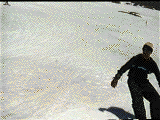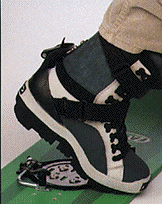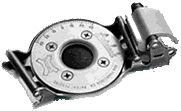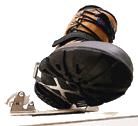New Snowboard Bindings Help Keep Your Butt Off the Snow
 The days of snowboard bindings that hold your feet down with straps are numbered. Already the step-ins are claiming a double-digit chunk of the
market, and according to the folks who make these things you can expect
step-ins to outnumber strap-ons by the end of next season.
The days of snowboard bindings that hold your feet down with straps are numbered. Already the step-ins are claiming a double-digit chunk of the
market, and according to the folks who make these things you can expect
step-ins to outnumber strap-ons by the end of next season.
This isn't a just a sales pitch for the latest technology -- there are quite a few reasons why step-in's make sense. First, they give you that graceful look and feel of a skier coming off the chair lift.... But really, what this breed of binding accomplishes is to keep your butt out of the snow, get one or two extra runs during the day (even more if you consider the random mornings most riders experience when a broken cam or lost nut sends them to the shop while their compadres are getting the fresh), and most importantly, step-ins offer better feel and quicker edge response.
Step-ins have been on the market for four years now, and the number of manufacturers getting into the game keeps growing. K-2 and Switch led the charge, with Device not far behind. Designs by Flytrap and T-Bone have introduced new permutations to the concept, and DNR, Blax, F2 and some other companies have formed alliances to blend boot and binding technologies. The two biggest manufacturers-Burton and Ride-are taking their time, though, before entering the muddle. Both companies contend they want to put out a quality product, and thus they'll wait another year before coming out with a product. Ride has filed a patent dispute against Switch (a story unto itself), but the most realistic way to look at this pair of manufacturers is to acknowledge that they are in the rare position (among snowboard companies) of not needing to chase after dollars with new technology. Airwalk has also made a similar decision to delay shipping its Quad step-in system, which further supports the decision by large manufacturers to take a long and careful look at this market before deciding how and best to enter it..
The good news for snowboarders is that this is probably the last year before the bandwagon gets over-crowded and junked-out, and as such, it might be your last opportunity to objectively educate yourself on the basic design decisions manufacturers are making, and then figure out what style makes the most sense to them. In that spirit, here's a completely over-simplified run-down of what the current leading step-in manufacturers--K2, Switch, and Device-are up to. These companies come from three different schools of thought with regards to the best way to attach your foot to the board, so all that you have to do is figure out in . All of these step-ins are compatible with 4X4 and 3-D hole patterns, which covers 98% of the boards out there. Most importantly, these three manufacturers offer vast improvements over strap-ons, so it's impossible to make a bad choice.
School o' Thought: Heel Toe
 The K2 Clicker was designed for performance. K2 developed the binding with Shimano, that bicycle pedal company, to adapt it's click-in pedal system to snowboarding. With a cleat running underneath the arch of you foot and
clamping in near the toe and heel, K2 will put you on the edge, literally.
Because the unit's leverage points are closest to the edges of the board,
your weight gets onto the edges without any of that loose strap mush in
between. When you're carving or need to hold an edge after catching a big
air, this elimination of play in the heel and toe will mean the difference
between cruising away for your victory turns, or bailing most ingloriously.
The K2 Clicker was designed for performance. K2 developed the binding with Shimano, that bicycle pedal company, to adapt it's click-in pedal system to snowboarding. With a cleat running underneath the arch of you foot and
clamping in near the toe and heel, K2 will put you on the edge, literally.
Because the unit's leverage points are closest to the edges of the board,
your weight gets onto the edges without any of that loose strap mush in
between. When you're carving or need to hold an edge after catching a big
air, this elimination of play in the heel and toe will mean the difference
between cruising away for your victory turns, or bailing most ingloriously.
BINDING/BOOT
 The Clicker binding itself is a tribute to a chameleon's diet, or in other words, it's durn light. Of the two versions of the system the XLT($179)
weighs in at 562 grams (1.3 lb.). Traditional bindings weigh over 3 lb. a
pair, so it shouldn't be hard to imagine that these bindings will help you
put some air underneath your board. For the budget-minded, the
The Clicker binding itself is a tribute to a chameleon's diet, or in other words, it's durn light. Of the two versions of the system the XLT($179)
weighs in at 562 grams (1.3 lb.). Traditional bindings weigh over 3 lb. a
pair, so it shouldn't be hard to imagine that these bindings will help you
put some air underneath your board. For the budget-minded, the  BLT($139)
weighs 842 grams and offers the same performance enhancements. A big plus
for the Clicker is that both K2 and Shimano have put some brain cells into
coming up with a similarly light-weight and performance-oriented line of
boots. As a result, there are seven models for men and three women's designs
to choose from.
BLT($139)
weighs 842 grams and offers the same performance enhancements. A big plus
for the Clicker is that both K2 and Shimano have put some brain cells into
coming up with a similarly light-weight and performance-oriented line of
boots. As a result, there are seven models for men and three women's designs
to choose from. 
K2 offers the Kicker, (a durable, all-mountain boot for men
and women - $179), the Yeti(a burly all-mountain boot for men and women - $219), and the FS Gump (a fully-adjustable external highback that performs like a conventional freestyle boot/binding set-up, men's only - $229).

Shimano is offering the the Half Cap (the freestyler's choice, men's and women's - $189), Double Tall (flexible like the Half Cap, but taller, men's only - $199), Enduro (the internal flex-hinge mechanism within the high back offers total medial flexibility, i.e. bone-out heaven, men's only - $219), and the Couloir (a total high-tech, power-strapped freeriding extreme boot with adjustable external high back and a pretty blue color, men's only - $239). The boots themselves feel a lot different than your regular soft boots. They're stiffer because of the built-in highback, as well as tighter because of the internal foam construction. As a result it might take you a day to get used to the construction, but by coming up with a wide spectrum of boots for all styles of riding, K2 and Shimano offer something for every rider.
Probably the only drawback to this system that you'll hear about is that snow sometimes fills up the binding plate when you take your boot out. Most riders have become adept at digging this out with the safety catch that sticks up from the binding. In all seriousness, if you play in the snow, you've got to expect to get a little snow, so don't let this stop you from having fun. The upsides to K-2's offering are numerous: the bindings are light, the low profile of the cleat on the boot's underside doesn't inhibit hiking or kick up sparks as you walk across the parking lot, and the variety of boots fit any style of riding. For a high-performance boot/binding combination with a bullet-proof design, you can't go wrong with the Clicker. At about $40 more than a traditional soft boot/binding set-up, the Clicker system will pay for itself in convenience and enhanced performance.
The boots themselves feel a lot different than your regular soft boots. They're stiffer because of the built-in highback, as well as tighter because of the internal foam construction. As a result it might take you a day to get used to the construction, but by coming up with a wide spectrum of boots for all styles of riding, K2 and Shimano offer something for every rider.
SWITCH
School o' Thought: Side to Side
 Built with burly simplicity, the Switch Autolock Binding's claim to fame is that it has only one moving part. When you compare this fact to all the
different things that can go wrong with the straps, nuts, and highbacks of
traditional bindings, you might be tempted to leave your four-pound tool kit
(standard for snowboarders who rode in the early days) back in the parking
lot. This year Switch is offering two models: the Autolock 100 ($149), and
the Autolock 500 ($179). The only difference between the two models is that
the 500 has a teflon-coated rotor disk that prevents snow build-up. This
rotor disk is also slotted so that riders can offset their stance.
Built with burly simplicity, the Switch Autolock Binding's claim to fame is that it has only one moving part. When you compare this fact to all the
different things that can go wrong with the straps, nuts, and highbacks of
traditional bindings, you might be tempted to leave your four-pound tool kit
(standard for snowboarders who rode in the early days) back in the parking
lot. This year Switch is offering two models: the Autolock 100 ($149), and
the Autolock 500 ($179). The only difference between the two models is that
the 500 has a teflon-coated rotor disk that prevents snow build-up. This
rotor disk is also slotted so that riders can offset their stance.
 BINDING/BOOT
BINDING/BOOT
Like K2, Switch has come up with a step-in system with a cleat attached to the underside of the boot. Unlike K2, Switch has placed the connection
points for the boot on the outside of the foot so that your boot attaches at
the instep and outstep. So instead of a heel-to-toe connection, you've got a
side-to-side connection to the board. Their thinking is that by putting the support
structure close to the rider's leg bones, it improves toe-to-heel weight
transfer, which is an interesting way to look at it. As more manufacturers
enter the market, you'll probably a good number of them following this
design decision to lock down the sides of the boots.
 There's no doubt that Switch has come up with a bomb-proof design-the binding is lightweight (1.5 lb./pair), snow doesn't build up at the contact
points, and there's no learning curve for riders trying to figure out how it
works. What's more, Switch has partnered with
There's no doubt that Switch has come up with a bomb-proof design-the binding is lightweight (1.5 lb./pair), snow doesn't build up at the contact
points, and there's no learning curve for riders trying to figure out how it
works. What's more, Switch has partnered with  several boot manufacturers to
produce Autolock-compatible boots (a page out of the Microsoft licensing
strategy? will Switch one day own Microsoft? baited breath smells like fish).
Switch manufactures three of its own boot designs in-house; the Point One (freestyle, $225), the Seven (freeride, $235) and the Zero (linerless
pipe and park boot $208). Van's has come out with the Skylark ($199.95),
the Caprice ($249.95) and the Axiom ($229.95) all of which are compatible
with the Autolock system. Another manufacturer making Autolock-compatible
boots is Gordo, producing the Gordo (a flexible, shifty-lover's boot, $214).
several boot manufacturers to
produce Autolock-compatible boots (a page out of the Microsoft licensing
strategy? will Switch one day own Microsoft? baited breath smells like fish).
Switch manufactures three of its own boot designs in-house; the Point One (freestyle, $225), the Seven (freeride, $235) and the Zero (linerless
pipe and park boot $208). Van's has come out with the Skylark ($199.95),
the Caprice ($249.95) and the Axiom ($229.95) all of which are compatible
with the Autolock system. Another manufacturer making Autolock-compatible
boots is Gordo, producing the Gordo (a flexible, shifty-lover's boot, $214).
The only downside for the Switch system is that the boots are on the heavy side, and by putting the cleat on the outside they're not as easy to dance in. If you do the majority of your riding with the assistance of a lift, this shouldn't be an issue. Other than that, the Autolock offers a solid connection to the board, an easy to use design, and a variety of boots to choose from.
DEVICE MFG. CORP.
School o' Thought: Das Boot
 Device Mfg. Corp. built their binding with the boot in mind. One of the great things about snowboarding is the boot--they're comfortable, they're
sexy, and if pressed, you could snow wrestling in them, no problem. What
Device was looking to do was preserve the divinity of soft boots while
escaping the hell of straps and buckles.
Device Mfg. Corp. built their binding with the boot in mind. One of the great things about snowboarding is the boot--they're comfortable, they're
sexy, and if pressed, you could snow wrestling in them, no problem. What
Device was looking to do was preserve the divinity of soft boots while
escaping the hell of straps and buckles.
 Something to note here: the above boot/binding set-ups have high-backs built
into the boots. As a result you'll walk a little stiffer, and probably a
little heavier (important if you hike). Device has kept the highback out of
the boot by designing a step-in system that closely resembles a traditional
set-up, except there are no straps. What holds your boot to the binding are
a peg built into the heel of the boot, and a bar underneath the toe of the
boot that locks in to the binding ($178). The result is a seemingly low-tech approach that holds your solidly onto the board and preserves the feel of the soft boot as well as its relationship to the high- or lowback. Device
shares a similiarity with K2 in that they have adopted a heel/toe approach.
The important differentiation is that Device has built a system for riders
who don't want to give up the well-known (and loved) comfort, response, and
feel of soft boots.
Something to note here: the above boot/binding set-ups have high-backs built
into the boots. As a result you'll walk a little stiffer, and probably a
little heavier (important if you hike). Device has kept the highback out of
the boot by designing a step-in system that closely resembles a traditional
set-up, except there are no straps. What holds your boot to the binding are
a peg built into the heel of the boot, and a bar underneath the toe of the
boot that locks in to the binding ($178). The result is a seemingly low-tech approach that holds your solidly onto the board and preserves the feel of the soft boot as well as its relationship to the high- or lowback. Device
shares a similiarity with K2 in that they have adopted a heel/toe approach.
The important differentiation is that Device has built a system for riders
who don't want to give up the well-known (and loved) comfort, response, and
feel of soft boots.
Device is the only producer of their boots (look for products from Lamar and Shift in the near future), and they currently offer three designs: The Titan (burly all-terrain boot, not for sissies, price $219), the Apollo (a freeriding boot that can take you anywhere on the mountain, price $210), and the Sputnik (low cut freestyle park and pipe boot for the jib-minded, price $205).
As other manufacturers get into the game, they'll have to contend with the obvious head-start that these three companies have on developing solid, performance-oriented step-in technology, as well as having a lot of widespread on-snow testing. Also, look for some standards to emerge as companies begin to partner and develop blocks of support for one step-in solution over another. There's never going to be just one step-in (that'd be like saying there was only one way to do it), but the differences between step-in approaches will, over the next few years, boil down to probably three or four standard approaches.
As a rider, you don't have to worry about all this. Just have to figure out which step-in philosophy you cotton to, and then go out and set yourself up. Do it this season if you can--step-ins really do make riding even more fun (hard to imagine, but true) for a very simple reason--they help you develop a more direction connection between how your shift your weight, and how your board responds. And it's a connection that will not be cheapened by big drops, sheet ice, or slopes full of crud.
— Jim Humes, Mountain Zone Contributor
More, more, more...


The Mountain Zone Bookstore is now featuring "Basic Essentials of Snowboarding" and tons of other software, books, and guides on working and playing in the mountains.